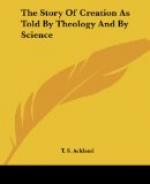Against this view several objections may be brought. In the first place, as has been already noticed, we cannot treat the account of the Creation as derived from ordinary human sources. Either it is a revelation from the Creator or it is nothing. Now we can readily admit that a man, speaking of an event which lie had witnessed, but did not understand, would describe it as it appeared to him, but we cannot admit this supposition when the work is described by the Great Artificer Himself. In the next place, the temperature of the earth’s surface must in this case have been affected by the sun, and must therefore have been more or less dependent upon latitude—and in the third place the distinction between day and night must have come into operation, whereas the narrative implies that it was yet incomplete.
2. The other possible interpretation is, that at this period the concentration of light and heat in the sun was so far completed that he became the luminary of the system, which had hitherto derived its light and heat from other sources. Probably, for a long time, the internal heat of the planets may have been so great that they were a light to themselves. This state of things, however, must have come to an end before animal or vegetable life could have existed on their surface, but other ways exist, and are in operation in other parts of the universe, by which light and heat might have been supplied independently of the sun. That light which is now gathered up in the sun might for a long time have existed as a nebulous ring, similar to the well-known Ring Nebula in Lyra. Any planets existing within such a ring would probably derive from it sufficient light and heat. Or the nebulous matter, in a luminous state, while slowly advancing to concentration, might as yet have been so diffused as to fill a space in which the earth’s orbit was included. In either case the earth would have received a uniform diffused light, without any alternations of night and day. It is of course impossible that we should be able to say whether there are any worlds in which such a state of things prevails at present. Up to this time, with one possible exception, [Footnote: “Sirius is accompanied by a 10 mag. star, whose existence was suspected (like that of Neptune), long before its discovery by Alvan Clark in 1861, from the irregular movements of its primary. But though it appears so small, its disturbing effects can only be accounted for on the supposition that its mass is at least half that of Sirius, in which case its light must be very faint, possibly wholly reflected.” (Webb’s Celestial Objects, p. 202.)] the only worlds which the telescope has revealed to us, beyond the limits of our own system, are self-luminous. No reflected light is strong enough to make its existence perceptible at such enormous distances in the most powerful telescope which has yet been constructed.




